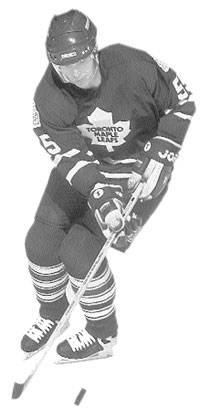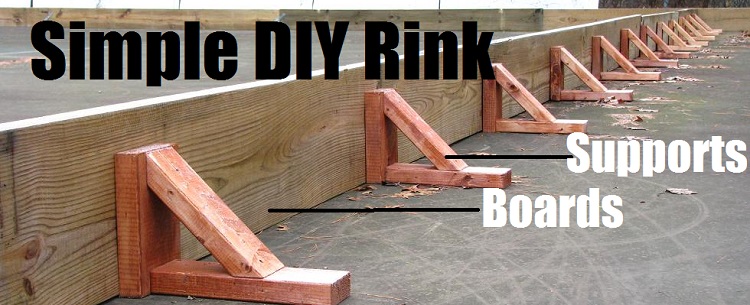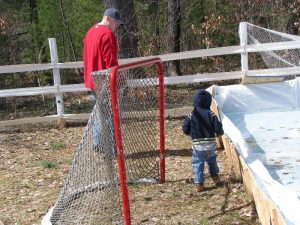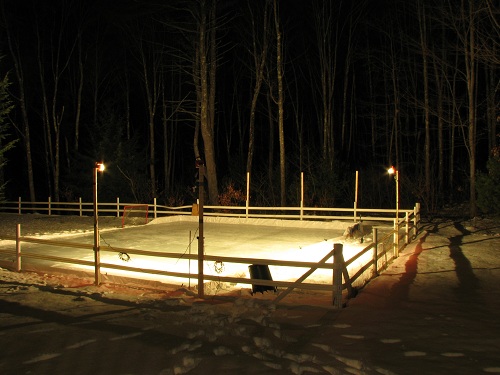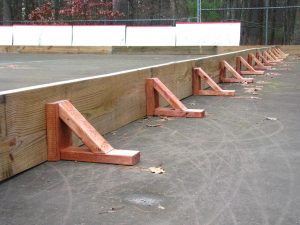Duck soup: Anaheim’s recipe for success (1996)
By Alex Carswell
Nov 6, 2001, 20:54
What would the coach of an NHL expansion team hope to see if he could look into the future? Probably a team where first-round draft choices are playing and contributing on a regular basis. Probably a team that had shaken the label “easy game” for opponents scanning their schedules. And probably a team that now expects not just to compete, but to win.
Well, as he looked around the locker room earlier this season, Mighty Ducks coach Ron Wilson must have thought he’d gone through the looking glass. The “expansion” Ducks had just reeled off four straight wins, five in a row at home, and taken down the past two Stanley Cup champions by a combined score of 13-6 in the process. The veterans were playing solid hockey, and the kids were starting to show signs of living up to management’s high expectations—some way ahead of schedule.
Paul Kariya, the first-ever Ducks draft pick (who sat out the team’s inaugural season before contending for Calder Trophy honors last year), was among the league leaders in goals scored. Oleg Tverdovsky was showing flashes of the brilliance that earned him the label “the Russian Bobby Orr” when he was drafted second overall in 1994. And Chad Kilger, an 18-year-old behemoth projected by management to be Kariya’s center of the future, had earned himself a spot on the roster and potted his first few NHL goals.
Special K’s
Kilger, in fact, had become something of a sensation in the preseason, playing bet-ween Kariya and Todd Krygier on a unit dubbed the “Special K” line. And while he provided the high fiber content you’d expect from a 6’5” power-forward prototype, he also displayed a sugar coated scoring touch, racking up four goals and 10 points in eight games. Those totals were good enough to tie him with Krygier for second, behind only Kariya, in Anaheim’s preseason scoring race.
How does an 18-year-old draft pick at his first NHL training camp end up centering the team’s top line?
“In talking with our scouts,” said Wilson, “Dave McNab in particular, he thought Chad was ready to play right away, so I thought, well, let’s get him out there. What we had planned for the future was that Chad would be the guy playing with Paul Kariya, so we might as well see right off the bat.”
And early on, things looked great. But Kilger pressed a bit as the regular season opened, and the Special K’s found themselves united only sporadically. But Wilson hasn’t lost any of the faith that Kilger earned himself over the exhibition schedule.
“I think Chad is just a little overwhelmed with the National Hockey League,” says Wilson, who scratched Kilger for an early-season match in Pittsburgh, and was pleased with how he bounced back. “But he’s been getting better and better, and that’s what you look for in young players. Sometimes players start fast and then fade in a hurry. You’re much better off building a guy; start with a solid base and go from there. And that’s what we’re trying to do with Chad.”
And when the team was struggling at the start of the season (dropping five of their first six games), Wilson didn’t see Kilger, or his other youngsters, as being the problem.
“You hate to rely on 18, 19, 20-year-old guys to show the 27, 28-year-old guys how to play,” he said after a loss to Philadelphia at the Arrowhead Pond. “It’s supposed to be the other way around.”
As for Kilger, Wilson is satisfied with his rate of progress.
“He’s played solid defensively, he’s created some chances. That’s all you can ask him to do.”
Wilson might also ask him to be dominant physically, the way Kilger was against Winnipeg the night he scored his first NHL goal. On his first shift he leveled Jets winger Dallas Drake, knocking him into the corner boards and out of the game with a fierce, clean check. And Kilger himself acknowledges the need to play tough.
“That’s part of my game,” he said after the 6-2 contest in which his tally proved to be the winner. “I’ve got to get into the game physically right from the start. If I don’t do that, I’m going to be ineffective out there.”
Already a star
Kariya, already a legitimate NHL star at the tender young age of 21, sees great things for his on-again, off-again center.
“In the past 10 years, not too many 18-year-olds can say they’ve played in the NHL—he’s made a great accomplishment just in that,” says Kariya. “He’s got a great attitude, he’s very humble and he takes things in stride, and I think that’s going to bode well for him. I’m sure that in coming years Chad and I will be playing a lot together.”
And that’s something that would bode well for any player—just ask winger Todd Krygier.
“He’s got great speed, great moves, and he can make plays and score goals. It’s been a good experience playing with him,” says Krygier, “and it’s given me more confidence in my play, too. Trying to feed him and make him the best player he can be, it’s helped me.”
Actually, Krygier helped himself quite a bit last season, when there was no Special K line. After being acquired from Washington for a fourth round draft pick in February, Krygier finished fourth on the Ducks in scoring, on pace for what would have been a career-best 52 points over a non-Lockout shortened schedule. That performance, coupled with the defensive savvy coveted by coach Wilson, was what earned Krygier, a new three-year contract and a chance to become part of Anaheim’s alliterative unit.
“I don’t think we’ll be together all year,” says Krygier, 29, of the Special K corps. “It’ll be on and off, just because Chad’s so young. Some games, like against Pittsburgh, they (wanted) him to just watch and learn. Other games he might play with different lines until he really develops his style of play. But I know that we’ll probably end up together somewhere along the line.”
Which is the way Wilson sees things shaping up as well. He likes the chemistry he saw in the preseason, and feels that once Kilger settles into his game, the trio will be reunited.
“They’re all the three parts of a line that any coach is looking for: a big power center, a playmaking, scorer-type winger, and somebody who’s going to play with them who can skate as well and is defensively conscious,” says Wilson. “And maybe another 10, 15 games into the season they’ll be able to come together and gel.”
Walking a tightrope
But this year’s Mighty Ducks team has more than just the Special K’s. Even before the surprising emergence of Kilger as an important member of the team, Wilson proclaimed his squad capable of making the playoffs in just their third season. And he bristled good-naturedly when asked by syndicated radio personality Jim Rome whether Anaheim would finish ahead of the cross-town rival LA Kings.
“What kind of a question is that?” replied Wilson. “Of course we will.”
And it’s that kind of confidence that had the Ducks flying high when the New Jersey Devils came to town.
“I said it early on and I’ll say it again: we’re a playoff team,” declared the coach after his charges dispatched the Stanley Cup champions, 6-2. “If we stay disciplined and use our speed when the opportunities are there, we can beat anybody. I think we’ve proven that.
“But I’m not a fool,” added Wilson. “I don’t expect to go into every building and win, and win by five goals at home every night.”
That tightrope between optimism and realism is one that Wilson fights to stay on, both because of the makeup of his team and the fact that there is a long-term plan in place.
“It gets to be frustrating for me sometimes,” says Wilson, “because I have so many young guys. But that’s part of my job; to be patient and understand you have to learn to walk before you can run.”
Yet the pressure to succeed can be a dangerous thing. The fans want to win. Management wants to win. In fact, the cover of the current Mighty Ducks media guide displays the motto “The Future is Now.” Pressure? Of course Wilson wants to win, too. But at what cost?
“It’s so hard from a coach’s perspective not to lose the focus on where you’re going,” says Wilson. “The idea is that everybody sticks together, and you can’t skip steps. When you try to skip steps to get there a little faster, usually you stumble and fall back down the staircase—and that’s what we have to avoid doing.
“You’ve seen it happen everywhere. (A team) will go on their plan for two or three years and it’s looking okay, and then somebody’s expectations change. Maybe you do a little better one year than perhaps you should have done. Then you say we should jump off from this (higher) point, when you’re really at this (lower) point. And when you jump, you miss—and, boom, you fall right back down the stairs again.”
Ducklings must grow
So Wilson hopes to win his share of games and make the playoffs while not sacrificing the development of his many “ducklings,” as he tagged the core of youngsters who are not rookies, but not seasoned veterans either. Guys like Oleg Tverdovsky, Milos Holan—whose battle with leukemia is something everyone wants to win right now—Mike Sillinger and Steve Rucchin.
For his part, Rucchin has developed into one of the team’s best players. A supplemental draft pick in 1994, the 24-year-old center was playing Canadian college hockey—the hockey equivalent of Siberian exile—at the University of Western Ontario when the Ducks discovered him. Since coming to Anaheim last year, he has demonstrated exactly the kid of two-way proficiency that Wilson appreciates.
“Paul Kariya’s clearly our best player, but from a coach’s point of view Steve Rucchin’s the kind of guy who, when the game is on the line—when you’re a goal up or a goal down—you’re looking down (the bench) to say ‘Rucchin, get out there.’ And he just does his job.”
Rucchin, who had long ago given up on a pro hockey career and was pursuing a career in medicine, is now considered a vital part of Anaheim’s future. And Wilson is thrilled with his development, both on and off the ice.
“Last year, he was very wishy-washy about being an NHLer. He didn’t know how to handle it. But now he’s seen the dressing room and he’s starting to take a leadership role. And he’s starting to demand more of himself—he’s not just happy with being in the lineup. Now he wants to score a couple of goals and a couple of assists, and make sure he’s not on the ice for any goals against.
“He’s 24 years old,” notes Wilson. “He’s got another 10 years ahead of him—if he doesn’t bail out on us and become a doctor.”
Sillinger is another 24-year-old who has found new life on Anaheim’s Pond. The high-scoring Junior player was relegated mostly to fourth-line duty over four years with a very deep Detroit squad. But since coming to Anaheim he has seen time centering for Kariya, and more recently on the left side of Kilger—where he seems to have helped the youngster regain his confidence and his touch.
The other team
That Anaheim has acquired and drafted players who are making an impact right on schedule is no surprise given the past successes of their management team. General Manager Jack Ferreira had an excellent draft history while with the New York Rangers, Minnesota North Stars and San Jose Sharks. He chose his team wisely in the 1993 Expansion Draft, making goaltender Guy Hebert the very first Mighty Duck. And he hired a coach with the patience to see his mix of kids and expansion-draft veterans through a long-term plan.
“Realistically, to win the Stanley Cup,” Wilson muses, “I’d say you can do it in seven years the way things are right now. When you’re drafting all these 18, 19-year-old kids, then they’re all mature at 24, 25. Then you’re looking at a situation like the Edmonton Oilers and the New York Islanders when they came into the league. It took them seven, eight years to win the Stanley Cup. And if you build through the draft, that’s what it’s going to take you.”
One other thing those two dynasties had in common, however, is something that’s not so common in hockey today: stability, both in the front office and behind the bench. Does the man who was just given a one year contract extension see a stable coaching presence as part of the long term Stanley Cup strategy?
“That’s very important,” notes Wilson. “But it’s easy for me to say—I don’t control that. But when you analyze any successful franchise in any sport, the formula for success is the same. And stability is part of that.”
In other words, with enough patience—from management, from the coach and from the fans—what started as an ugly bunch of ducklings might just blossom into a Stanley Cup swan.
This first appeared in the 01/1996 issue of Hockey Player Magazine®
© Copyright 1991-2001 Hockey Player® and Hockey Player Magazine®


 How it Works:
How it Works:




